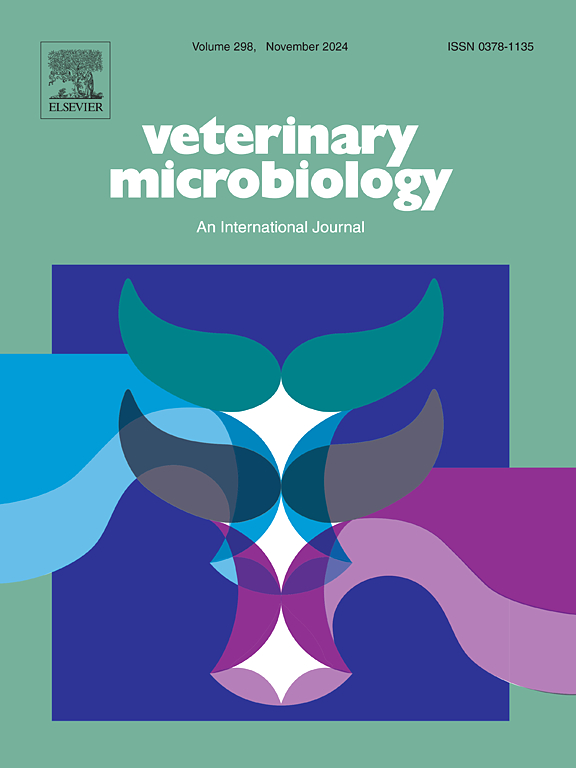First isolation of Leptospira interrogans from follicular fluid of naturally infected cows
IF 2.4
2区 农林科学
Q3 MICROBIOLOGY
引用次数: 0
Abstract
The presence of leptospires in the follicular fluid has only been confirmed through molecular techniques, as culturing leptospires is extremely challenging. The lack of studies demonstrating the viability of leptospires in this site limits a deeper understanding of pathogenesis. Therefore, this study aimed to cultivate and molecularly characterize Leptospira spp. from follicular fluid and uterine tissue samples collected from naturally infected cows. A total of 85 cows from herds with leptospirosis were selected and 53 follicular fluids (FF) and 85 uterine fragments (UF) were collected after slaughter. The samples were seeded into T80/40LH, and evaluated by Darkfield Microscopy (DFM). Positive cultures were tested by lipL32-PCR to confirm the presence of pathogenic Leptospira spp. Positive tubes were submitted to serogrouping and genotyping by sequencing of the secY gene. A maximum likelihood (ML) tree was constructed. A total of 33/85 (39 %) cows were positive, 16/53 (30.2%) only in FF, 14/85 (16.4 %) only in UF, and three in both samples. It was possible to obtain one isolate from FF, serogrouped as Icterohaemorrhagiae. Six samples were sequenced by secY. All of them were identified as L. interrogans, with > 99 % identity. The ML tree revealed that all sequences belong to a group with strains close to serovar Hardjo. Herein, we highlight the presence of live L. interrogans in follicular fluid, emphasizing it as an important site of infection, as leptospires could impair embryo production. The similarity of the strains involved to highly virulent strains in humans raises concerns, posing a potential zoonotic risk.
首次从自然感染奶牛的卵泡液中分离出钩端螺旋体
由于培养钩体极具挑战性,卵泡液中钩体的存在仅通过分子技术得到证实。缺乏证明钩端螺旋体在该部位生存能力的研究限制了对发病机制的深入了解。因此,本研究旨在从自然感染奶牛的卵泡液和子宫组织样本中培养钩端螺旋体并对其进行分子表征。选取钩端螺旋体病牛群85头,屠宰后采集卵泡液(FF) 53份,子宫碎片(UF) 85份。将样品播种到T80/40LH中,通过暗场显微镜(DFM)进行评估。对阳性培养物进行lipL32-PCR检测,确认致病性钩端螺旋体的存在,并对阳性培养管进行血清分型和sey基因测序分型。构造了极大似然树。共有33/85头奶牛(39 %)呈阳性,16/53头奶牛(30.2%)仅呈FF阳性,14/85头奶牛(16.4 %)仅呈UF阳性,两种样品均有3头呈阳性。有可能从FF中获得一株分离物,血清分类为黄疸出血热。6份样品经secY测序。经鉴定均为L.审讯者,具有>; 99 %的同一性。ML树显示,所有序列都属于一个与血清型Hardjo接近的菌株群。在这里,我们强调活的质询乳杆菌存在于卵泡液中,强调它是一个重要的感染部位,因为钩端螺旋体可能损害胚胎的产生。所涉及的菌株与人类高毒力菌株的相似性引起了关注,构成了潜在的人畜共患风险。
本文章由计算机程序翻译,如有差异,请以英文原文为准。
求助全文
约1分钟内获得全文
求助全文
来源期刊

Veterinary microbiology
农林科学-兽医学
CiteScore
5.90
自引率
6.10%
发文量
221
审稿时长
52 days
期刊介绍:
Veterinary Microbiology is concerned with microbial (bacterial, fungal, viral) diseases of domesticated vertebrate animals (livestock, companion animals, fur-bearing animals, game, poultry, fish) that supply food, other useful products or companionship. In addition, Microbial diseases of wild animals living in captivity, or as members of the feral fauna will also be considered if the infections are of interest because of their interrelation with humans (zoonoses) and/or domestic animals. Studies of antimicrobial resistance are also included, provided that the results represent a substantial advance in knowledge. Authors are strongly encouraged to read - prior to submission - the Editorials (''Scope or cope'' and ''Scope or cope II'') published previously in the journal. The Editors reserve the right to suggest submission to another journal for those papers which they feel would be more appropriate for consideration by that journal.
Original research papers of high quality and novelty on aspects of control, host response, molecular biology, pathogenesis, prevention, and treatment of microbial diseases of animals are published. Papers dealing primarily with immunology, epidemiology, molecular biology and antiviral or microbial agents will only be considered if they demonstrate a clear impact on a disease. Papers focusing solely on diagnostic techniques (such as another PCR protocol or ELISA) will not be published - focus should be on a microorganism and not on a particular technique. Papers only reporting microbial sequences, transcriptomics data, or proteomics data will not be considered unless the results represent a substantial advance in knowledge.
Drug trial papers will be considered if they have general application or significance. Papers on the identification of microorganisms will also be considered, but detailed taxonomic studies do not fall within the scope of the journal. Case reports will not be published, unless they have general application or contain novel aspects. Papers of geographically limited interest, which repeat what had been established elsewhere will not be considered. The readership of the journal is global.
 求助内容:
求助内容: 应助结果提醒方式:
应助结果提醒方式:


